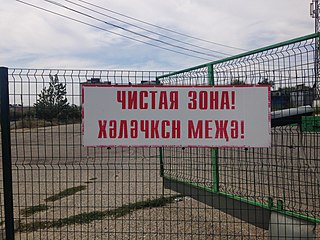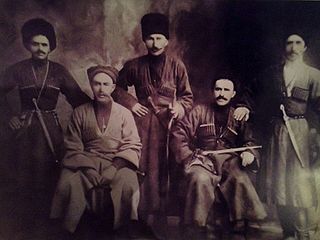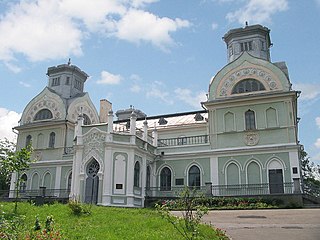Related Research Articles

Nazran is the largest city in Ingushetia, Russia. It served as the republic's capital from 1991 to 2000, until it was replaced by Magas, which was built for this purpose. It is the most populous city in the republic: 122,350 (2021 Census); 93,335 (2010 Census); 125,066 (2002 Census); 18,246 (1989 Census).

Kumyks are a Turkic people, living in Dagestan, Chechnya and North Ossetia. They are the largest Turkic people in the North Caucasus.

Kalmyk Oirat, commonly known as the Kalmyk language, is a variety of the Oirat language, natively spoken by the Kalmyk people of Kalmykia, a federal subject of Russia. In Russia, it is the standard form of the Oirat language, which belongs to the Mongolic language family. The Kalmyk people of the Northwest Caspian Sea of Russia claim descent from the Oirats from Eurasia, who have also historically settled in Mongolia and Northwest China. According to UNESCO, the language is "Definitely endangered". According to the Russian census of 2010, there are 80,500 speakers of an ethnic population consisting of 183,000 people.
Oleg Nikolayevich Trubachyov was a Soviet and Russian linguist. A researcher of the etymology of Slavic languages and Slavic onomastics, specialist in historical linguistics and lexicographer. He was a Doctor of Sciences in Philological Sciences, an academician of the Russian Academy of Sciences and served as the editor-in-chief of the Etimologiya yearbook. His works are on the etymology of Slavic languages and on East Slavic onomastics.

Beklemishevskaya Tower is a tower at the Eastern edge of Moscow Kremlin Wall. It was named after a boyar Ivan Bersen-Beklemishev, whose house had been adjacent to the tower from the Kremlin side. It was earlier known as Russian: Москворецкая tower based its position on the near Moskva River. It is similar to the other two towers standing at the other corners of the Kremlin triangle, Vodovzvodnaya and Uglovaya Arsenalnaya rowers. While these towers are cylindrical, all other towers of the Kremlin's Wall have been built on a square plan base.

The Shamkhalate of Tarki, or Tarki Shamkhalate was a Kumyk state in the eastern part of the North Caucasus, with its capital in the ancient town of Tarki. It formed on the territory populated by Kumyks and included territories corresponding to modern Dagestan and adjacent regions. After subjugation by the Russian Empire, the Shamkhalate's lands were split between the Empire's feudal domain with the same name extending from the river Sulak to the southern borders of Dagestan, between Kumyk possessions of the Russian Empire and other administrative units.

The Orstkhoy, historically commonly known under their exonyms: Karabulaks, Balsu, Baloy, are a historical ethnoterritorial society among the Chechen and Ingush peoples. Their homeland is in the upper reaches of the Assa and Fortanga rivers in the historical region of Orstkhoy-Mokhk. In the tradition of the Chechen ethno-hierarchy, it is considered one of the nine historical Chechen tukkhums, in the Ingush tradition as one of the seven historical Ingush shahars.

The Kórmchaia Book, also known as the Books of the Pilot (Russian: Ко́рмчая книга, Ко́рмчая from кормчий, Church Slavonic: кръмьчии 'helmsman, ship's pilot'; Pidalion or Nomocanon, are collections of church and secular law, which constituted guide books for the management of the church and for the church court of Orthodox Slavic countries and were also the transmission of several older texts. They were written in Old Church Slavonic and Old East Slavic.

Simsim was either a historical region or kingdom in North Caucasus during the Middle Ages, existing in the fourteenth century. It's predominantly localized roughly in Eastern Chechnya (Ichkeria), with some also connecting part of Kumyk Plain. Simsim is also localized in both Chechnya and Ingushetia. Its name may have been derived from the Chechen village of Simsir. However, according to folklore the King Gayur Khan was chosen as the leader of all Chechens by the Mehk-Kel. In its later years it allied itself with the Golden Horde before it was destroyed in 1395 by Timurlane, with that conquest of Timurlane being written about in the Zafarnama by Nizam al-Din Shami and the Zafarnama by Sharaf ad-Din Ali Yazdi.

The Lopukhin family was a noble family of the Russian Empire, forming one of the branches of the Sorokoumov-Glebov family.
Anton Loginov was a Russian Bolshevik Revolutionary, Communist Party member, journalist, writer, Soviet publicist, and propagandist of atheism.
Kumykia, or rarely called Kumykistan, is a historical and geographical region located along the Caspian Sea shores, on the Kumyk plateau, in the foothills of Dagestan and along the river Terek. The term Kumykia encompasses territories which are historically and currently populated by the Turkic-speaking Kumyk people. Kumykia was the main "granary of Dagestan". The important trade routes, such as one of the branches of the Great Silk Road, passed via Kumykia.
Semyon Alekseyevich Kamenev was an educator, professor, writer, Soviet propagandist of atheism and a scientific worker in the study of problems of religion and atheism.
Anatoly Vasilyevich Belov was a Soviet religion scholar and atheist propagandist. He was a First Deputy Chairman of the Council for Religious Affairs under the Council of Ministers of the USSR, an expert on Adventism and one of the authors of the Atheistic Dictionary and Atheist Handbook.

Vladimir Kapitonovich Nikolsky was a Soviet historian, ethnologist, translator, religious scholar, Doctor of Historical Sciences (1943), and professor.

Derevenskiy Bezbozhnik was an illustrated magazine, an organ of the Centre Soviet and Moscow Oblast Soviet of the League of the Militant Godless.

Decanonization or de-canonization – exclusion of a person's name from the list, catalog; the opposite of canonization. The list or catalog is the calendar of the saints or the church calendar. Decanonization, the exclusion of the saint's name from the calendars, was carried out in the Russian Orthodox Church, in the Catholic Church and in the Anglican Church.
Russian–Kumyk wars — a series of military conflicts between the Russian Tsardom and the Kumyk Tarki Shamkhalate and other Kumyk states and feudal possessions during the 16th–18th centuries. At the end of the 18th century, as well as during and after the Caucasian War, and throughout the end of the 19th and the beginning of the 20th centuries, conflicts continued in the form of uprisings in Shamkhalate, Northern Kumykia, Southern Kumykia, and in the form of anti-colonial protests of individual villages (societies). In the result of these wars and uprisings, some Kumyk areas and villages were destroyed several times over.
Khakass alphabets are the alphabets used to write the Khakas language.

Sulumbek Gorovozhev (Gandaloev) or Sulumbek of Sagopshi was an Ingush outlaw (abrek) who was known for his spectacular bank, train and shop robberies, made together with his colleague and comrade Zelimkhan as part of a violent struggle with the Russian authorities. He participated in the most high-profile incidents associated with Zelimkhan. Sulumbek is considered a national hero to the Ingush people, as well as one of the most famous Caucasian abreks.
References
- ↑ Терский острог был построен в 1567 году, не следует путать его с острогом, получившим название «Сунженский», который был построен русскими здесь же — в устье Сунжи, но несколько позднее — в 1590 году (Кушева Е. Н. Народы Северного Кавказа и их связи с Россией. — М.: Издательство АН СССР, 1963. — С. 365-366).
- ↑ Точное местоположение города на сегодняшний день не установлено. Даны ориентиры согласно ЭСБЕ (Терский // Энциклопедический словарь Брокгауза и Ефрона : в 86 т. (82 т. и 4 доп.). — СПб., 1890—1907.), привязка к которым была осуществлена несколько позже, так как Кизляр возник после постройки Терского города, а русло так называемого Старого Терека в XVII веке не существовало (см. раздел «Расположение»).
- ↑ Акаев Б. А., Атаев З. В., Гаджиев Б. С. Физическая география Дагестана. — М.: «Школа», 1996.
- ↑ Голикова Н. Б. Очерки по истории городов России конца XVII — начала XVIII в : моногр. / рецензенты: И. Д. Ковальченко, Е. Н. Кушева. — М. : Изд-во Московского университета, 1982. — 216 с. — Печатается по постановлению ред.-изд. совета МГУ. — 3580 экз.
- ↑ Defense of the Terek Fortress (in Russian)